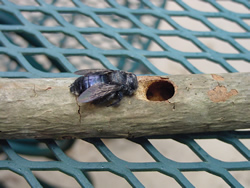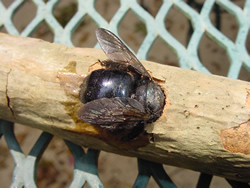| Question: These black bees are killing
my Ligustrum bush!!! I hear buzzing in the stems at night.
The stems or limbs are dead. What are these bees and how
do I eliminate them?
Answer: The bees are not killing your
plant---they are just setting up housekeeping in dead branches.
Carpenter bees are large (1 inch) yellow and black bees
which become active in early spring. They resemble bumble
bees but do not live in colonies, have fewer hairs, a shiny
black abdomen and no pollen sacs on the hind legs. Although
it is rare to be stung by one, their sheer size is scary
and people generally stay clear of them.
The female will go in and out of the nest so patience will
show where the entrance is. Killing individual bees with
a liquid insecticide will not destroy the bee's young. The
nest must be treated!
Biology
Carpenter bees get their name from their ability to drill
through wood and nest in it. Their drilling will create
a near perfect hole approximately ½ inch in diameter.
This hole is usually located on the underside of any wood
surface. Although the hole appears to be only an inch or
two deep, it doesn't end there. The female will turn 90
degrees and bore a channel from 6 inches to as long as 4
feet. This channel serves as a main corridor from which
she will drill small chambers a few inches deep. These chambers
become egg holders. She will deposit an egg, bring in some
food, and then seal it off to ensure the egg's development.
The male spends most of his time flying around the nest
playing guard. This is ironic as nature has left him ill
prepared; he has no stinger! Only the female can sting.
Simply killing the male will not solve your problem. To
eliminate carpenter bees, you must treat the nest!
Control
To treat the carpenter bee holes, dust the entrance hole
with Orthene. As the female enters the hole she will drag
the dust into the nest and kill all the larvae.
|






